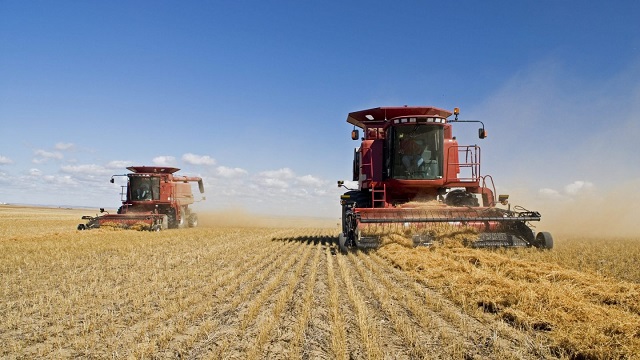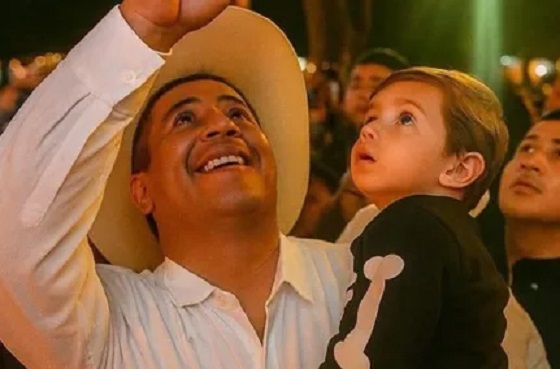Agriculture
Oil and gas products crucial to farms and food production

From the Canadian Energy Centre
By Cody Ciona
Without oil and gas products, Canada would not be the world’s fifth largest exporter of agricultural products
With fall in full swing, Canada’s farmers are hard at work harvesting the various grains and crops that help keep the country and the world fed.
Diesel and gasoline help power trucks, tractors and combines collecting the harvest. Through long days and long nights in the fields, refined petroleum products make sure the job gets done.
Synthetic rubber made from petrochemical products called styrene and butadiene, combined with natural rubbers, help improve tractor tires tread abrasion and sidewall shock resistance.
Lubricants derived from petroleum distillates keep machinery like grain augers and bale elevators working at peak performance, reducing energy expenditure and helping prevent corrosion and rust, reducing the chance of fire.
Natural gas is used to heat shops, greenhouses and keep livestock barns full as winter approaches. With Canada’s cold climate, ensuring farmers have warmth is crucial to Canada’s economy.
According to a Government of Alberta report, 77 per cent of the natural gas used on a 100-cow dairy farm is for water heating which is critical for cleaning and eliminating bacteria in the milking barn.
Natural gas is also critical for drying grain and removing moisture from the crop so farmers can deliver it to elevators and customers overseas.
A critical part of growing crops is fertilization which helps increase crop yields and plays a vital role in maintaining the world’s food supply.
Some studies estimate that fertilizer is responsible for at least 30-50% of a crop’s yield. Natural gas is used as feedstock by combining it with nitrogen to form nitrogen-based fertilizer. Petroleum distillates like mineral oil, naphtha, waxes and benzene play key roles in pesticide manufacturing which helps control pests and keep crops safe.
When doing work around the farm, it’s important to keep hands protected from cuts and scrapes. Synthetic materials like petrochemical based vinyl and polyvinyl chloride made from naphtha or ethylene used in work gloves help keep hands safe and warm.
Without oil and gas products, Canada would not be the world’s fifth largest exporter of agricultural products.
Agriculture
Danish Cows Collapsing Under Mandatory Methane-Reducing Additive

Cow feed additive Bovaer meant to curb climate change seems to be killing some Danish dairy cows
Since October 1, 2025, when many Danish dairy farmers began incorporating the synthetic additive Bovaer (containing 3-nitrooxypropanol) into their cows’ feed—alarming reports have come in of animals suffering from: stomach cramps, fevers, miscarriages, drastic drops in milk production, sudden collapses and in some cases, the need to be euthanized.
The first farmer from Denmark comes forward and talks about sick and dead cows, after giving his cows the Bovaer poison. 10/28 25. Remember that waste products from Bovaer, are passed on in milk and meat.
Short version video.
Boycott Arla and share, share, share. pic.twitter.com/fXzHgfWP3G
— Kent Nielsen Denmark (@Kentfrihedniels) October 30, 2025
In the shocking video below, Danish farmer Rene Lillehjælper discusses how her husband is driving their “cow ambulance” tractor— transporting yet another collapsed cow from their dairy farm—because of the “Bovaer Poison.”
Marketed as a “climate-friendly” methane reducer, this product—produced by the Dutch-Swiss giant DSM-Firmenich—became a legal requirement for Danish dairy farmers to add into their animal feed for 80 days or for their cows to be fed extra fat throughout the year.
Notably, farmers experimenting by removing Bovaer saw their herds recover rapidly, only for symptoms to return upon reintroduction. Yet, despite these red flags, authorities insist on pushing ahead, with an investigation only now underway.
These reports build on the concerns I outlined in my November 2024 investigation into Arla’s UK trials, where EFSA tolerance studies highlighted issues such as reduced feed intake, decreased organ weights (including ovaries and heart), and altered enzyme levels in cows at elevated doses—yet these effects were ultimately classified as “non-adverse” by regulators.
BREAKING: Methane-Reducing Feed Additive Trialled in Arla Dairy Farms
On November 26th, Arla Foods Ltd. announced via social media their collaboration with major UK supermarkets like Tesco, Aldi, and Morrisons to trial Bovaer, a feed additive, aiming to reduce methane …
What was even more troubling were the findings from my analysis of the safety assessment report, prepared by the UK’s Food Standards Agency (FSA) and Food Standards Scotland (FSS), reviewed by Animal Feed and Feed Additives Joint Expert Group (AFFAJEG) and the Advisory Committee on Animal Feedingstuffs (ACAF).
It stated: “In relation to safety studies for the consumer, a 2-year carcinogenicity study in Wistar rats showed “mesenchymal cell tumours were reported in 4 out of 49 females at the top dose of 300 mg/kg bw/day of 3-NOP given orally. Based on these results, the original study report concluded there was evidence of carcinogenicity in female rats.”
AFFAJEG noted potential for mesenchymal cell hyperplasia and benign tumours at high doses but, citing no malignant tumours or genotoxicity, concluded the additive is not carcinogenic at recommended inclusion rates.
ACAF echoed that the additive “can be considered safe for consumers.” Yet, their conclusion was seemingly contradicted by the following statement: “The additive should be considered corrosive to the eyes, a skin irritant and potentially harmful by inhalation.”
In a separate development, a May 2024 FDA letter addressed to Elanco US, Inc, (which has an agreement with DSM-Firmenich to market Bovaer) stated: “Based on a review of your data and the characteristics of your product, FDA has no questions at this time regarding whether Bovaer® 10 will achieve its intended effect and is expected to pose low risk to humans or animals under the conditions of its intended use.”
Ironically, the FDA letter included an attachment with the following warning:

It should be noted that Bovaer passed the FDA review in under 12 months—much shorter than industry standard.
Kjartan Poulsen, chairman of the National Association of Danish Dairy Producers, has received numerous calls from concerned farmers. “We have so many people who call us and are unhappy about what is happening in their herds,” he shared with TV 2.
He described the recurring issues as unusual and is urging reports of suspected Bovaer-linked miscarriages. Poulsen emphasized that any animal harm undermines the additive’s purpose: “This should give a climate effect – and if cows die from this, or they produce less milk, then the effect is minus.” He is calling for a temporary pause from Agriculture Minister Jacob Jensen and for farmers to cease use if welfare issues arise.
Approved by the European Commission in 2022 based on EFSA assessments, Bovaer was deemed safe for cows, consumers, and the environment, with claims of up to 30-45% methane reduction.
However, field experiences differ. Reports from Jyllands-Posten and TV 2 describe lower milk yields tied to miscarriages, plus collapses—some cows recovering with treatment but others needing to be euthanised.
Earlier whispers from Danish farmers included fevers, diarrhoea, mastitis, and even cow deaths attributed to Bovaer. One producer lost six animals in under a month. Critics label it “animal cruelty,” especially under mandatory use for farms with over 50 cows.
The Danish Veterinary and Food Administration acknowledges these reports and has enlisted Aarhus University to analyse real-world data, with initial findings expected after the 2025-26 new year.
The irony is stark: a product meant to “save the planet” for reducing methane is harmful to dairy herds, slashing productivity, and raising fears of contaminating the food chain—despite assurances it “breaks down fully” with no residues.
Yet, the true winners emerge clearly: DSM-Firmenich, cashing in on booming sales fuelled by mandates and climate subsidies, alongside powerhouse investors like BlackRock (holding ~3.3%) and Vanguard, who reap the rewards from this relentless Net-Zero drive.
If you appreciate the hard work that I do as an independent investigative journalist,
please consider supporting me with a paid subscription.
Agriculture
Cloned foods are coming to a grocer near you

This article supplied by Troy Media.
And you may never find out if Health Canada gets its way
Cloned-animal foods could soon enter Canada’s food supply with no labels identifying them as cloned and no warning to consumers—a move that risks public trust.
According to Health Canada’s own consultation documents, Ottawa intends to remove foods derived from cloned animals from its “novel foods” list, the process that requires a pre-market safety review and public disclosure. Health Canada defines “novel
foods” as products that haven’t been commonly consumed before or that use new production processes requiring extra safety checks.
From a regulatory standpoint, this looks like an efficiency measure. From a consumer-trust standpoint, it’s a miscalculation.
Health Canada argues that cloned animals and their offspring are indistinguishable from conventional ones, so they should be treated the same. The problem isn’t the science—it’s the silence. Canadians are not being told that the rules for a controversial technology are about to change. No press release, no public statement, just a quiet update on a government website most citizens will never read.
Cloning in agriculture means producing an exact genetic copy of an animal, usually for breeding purposes. The clones themselves rarely end up on dinner plates, but their offspring do, showing up in everyday products such as beef, milk or pork. The benefits are indirect: steadier production, fewer losses from disease or more uniform quality.
But consumers see no gain at checkout. Cloning is expensive and brings no visible improvement in taste, nutrition or price.
Shoppers could one day buy steak from the offspring of a cloned cow without any way of knowing, and still pay the same, if not more, for it.
Without labels identifying cloned origin, potential efficiencies stay hidden upstream. When products born from new technologies are mixed with conventional ones, consumers lose their ability to differentiate, reward innovation or make an informed choice. In the end, the industry keeps the savings while shoppers see none.
And it isn’t only shoppers left in the dark. Exporters could soon pay the price too. Canada exports billions in beef and pork annually, including to the EU. If cloned origin products enter the supply chain without labelling, Canadian exporters could face additional scrutiny or restrictions in markets where cloning is not accepted. A regulatory shortcut at home could quickly become a market barrier abroad.
This debate comes at a time when public trust in Canada’s food system is already fragile. A 2023 survey by the Canadian Centre for Food Integrity found that only 36 per cent of Canadians believe the food industry is “heading in the right direction,” and fewer than half trust government regulators to be transparent.
Inserting cloned foods quietly into the supply without disclosure would only deepen that skepticism.
This is exactly how Canada became trapped in the endless genetically modified organism (GMO) debate. Two decades ago, regulators and companies quietly introduced a complex technology without giving consumers the chance to understand it. By denying transparency, they also denied trust. The result was years of confusion, suspicion and polarization that persist today.
Transparency shouldn’t be optional in a democracy that prides itself on science based regulation. Even if the food is safe, and current evidence suggests it is, Canadians deserve to know how what they eat is produced.
The irony is that this change could have been handled responsibly. Small gestures like a brief notice, an explanatory Q&A or a commitment to review labelling once international consensus emerges would have shown respect for the public and preserved confidence in our food system.
Instead, Ottawa risks repeating an old mistake: mistaking regulatory efficiency for good governance. At a time when consumer trust in food pricing, corporate ethics and government oversight is already fragile, the last thing Canada needs is another quiet policy that feels like a secret.
Cloning may not change the look or taste of what’s on your plate, but how it gets there should still matter.
Dr. Sylvain Charlebois is a Canadian professor and researcher in food distribution and policy. He is senior director of the Agri-Food Analytics Lab at Dalhousie University and co-host of The Food Professor Podcast. He is frequently cited in the media for his insights on food prices, agricultural trends, and the global food supply chain.
Troy Media empowers Canadian community news outlets by providing independent, insightful analysis and commentary. Our mission is to support local media in helping Canadians stay informed and engaged by delivering reliable content that strengthens community connections and deepens understanding across the country.
-

 Business1 day ago
Business1 day agoTrump’s Tariffs Have Not Caused Economy To Collapse
-

 Daily Caller1 day ago
Daily Caller1 day agoTrump Reportedly Planning Ground Troops, Drone Strikes On Cartels In Mexico
-

 Daily Caller2 days ago
Daily Caller2 days agoNigeria Would Welcome US Intervention In Massacre Of Christians By Islamic Terror Groups
-

 Alberta19 hours ago
Alberta19 hours agoAlberta government’s plan will improve access to MRIs and CT scans
-

 Alberta2 days ago
Alberta2 days agoCanada’s heavy oil finds new fans as global demand rises
-

 Health2 days ago
Health2 days agoRFK Jr’s argument for studying efficacy of various vaccines
-

 Brownstone Institute1 day ago
Brownstone Institute1 day agoBizarre Decisions about Nicotine Pouches Lead to the Wrong Products on Shelves
-

 Business2 days ago
Business2 days agoCarney government should retire misleading ‘G7’ talking point on economic growth














